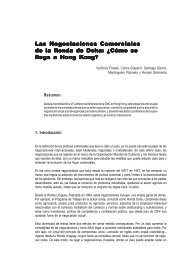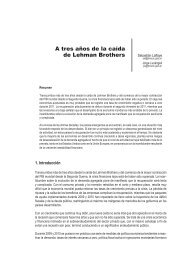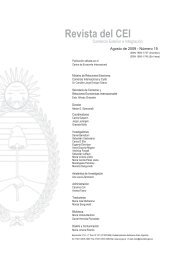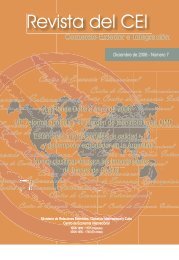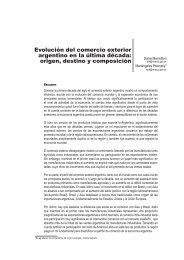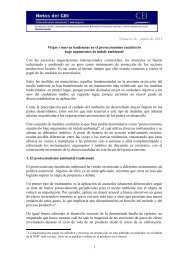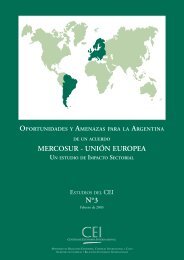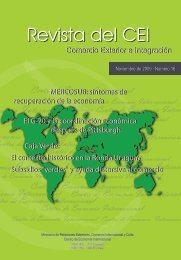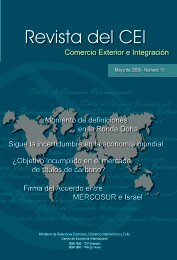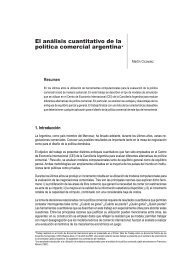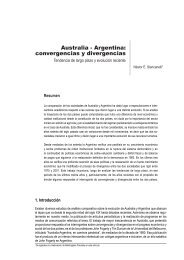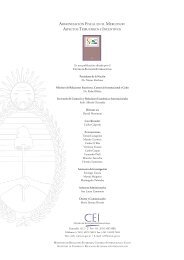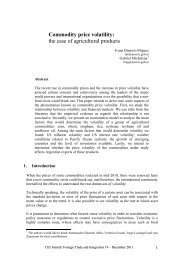SummaryAustralia – Argentina:Convergences and DivergencesLong-term trend and recent evolutionNéstor E. Stancanelli 1The comparison between Argentine and Australian societies has given rise to aca<strong>de</strong>mic interchange andspeculation regarding the reasons for a dissimilar <strong>de</strong>velopment. If the course of <strong>de</strong>velopment of the twocountries is analysed, differences regarding their economic levels and the quality of their institutions canbe seen from the founding of each state. Undoubtedly, in Australia, this is due to the importance of miningin addition to agriculture and to the establishment of a British-like parliamentary system. This small earlydifference persisted almost unchanged from 1900 until well into the nineteen seventies, which means thatduring this long period both societies have grown at the same pace and given rise to a significant<strong>de</strong>velopment of their human resources.Since the mid-seventies, Argentina’s economic growth has come to a halt and serious institutionalproblems that came from the 1930s substantially aggravated and led to the breakdown of the <strong>de</strong>mocraticsystem. From the economic si<strong>de</strong>, economic policies of exchange rate appreciation, fiscal <strong>de</strong>ficit, growingin<strong>de</strong>btedness to finance government expenditures, and continuous <strong>de</strong>ficit of the balance of payments werethe rule, with short intermissions, even after the <strong>de</strong>finitive restoration of <strong>de</strong>mocracy in 1983. Over the pastfour years, a major reversal of those policies and the restoration of strong economic growth have takenplace, changing the ten<strong>de</strong>ncy of divergence between the two societies that exten<strong>de</strong>d from 1975 to 2001.After analysing the long-term trend, this paper <strong><strong>de</strong>l</strong>ves into the period of the past thirty years and,particularly, the most recent past, with the aim of providing some responses to the questions that havebeen posed by different people, especially from the aca<strong>de</strong>mic sector, regarding the convergences anddivergences between both countries.1. IntroductionThere are several comparative analysis studies on the evolution of Australia and Argentina which consi<strong>de</strong>rthe period beginning in the second half of the nineteenth century up to recent <strong>de</strong>ca<strong>de</strong>s. Similarly, thepublication of newspaper articles and the broadcast of television and radio programmes <strong>de</strong>dicated to thesubject are regularly observed in our society. The most important Australian work, which en<strong>de</strong>avoured toprovi<strong>de</strong> an answer to the questions about the convergences and divergences between the two countriesregarding their economic and social progress, is the book entitled Australia and Argentina: On parallelpaths, written in the mid-1980s by John Fogarty and Tim Duncan, professors at the University ofMelbourne. This publication was the product of an intense intellectual interchange with Argentinecolleagues and even of a sabbatical year John Fogarty spent in Argentina.As to the similarities between the two countries, the aspects that chiefly call our attention are the vastnessof their territories, on the one hand, and their natural and human resource endowments, on the other. Athird feature is their participation in the world economy through the open mo<strong><strong>de</strong>l</strong> which characterisedinternational relations between 1850 and 1930, based on the exchange of primary products formanufactured goods from European centres, particularly the UK. Politically, this mo<strong><strong>de</strong>l</strong> was reinforced inAustralia as well as in Argentina by the respective constitutions enacted in 1853 in the former, and 1900 inthe latter. Another significant characteristic was given by public investment in infrastructure, largelysupported by external funding, as well as the formation of qualified state bureaucracies, the establishment1 Special thanks to Mariángeles Polonsky for her collaboration with tables and graphics on this article.
of extensive systems of free and compulsory education and access to public health care, which laid thefoundations for the integration of the new inhabitants coming from European immigration to their hostcountries.The above-mentioned parallelism begins to blur in 1930, at the inception of the Great Depression, andclearly comes to a halt as of the mid-1970s. In 1930, Argentina entered a period of political instability withthe irruption of <strong>de</strong> facto governments, which would last for over 50 years, compromising both <strong>de</strong>mocracyand the country’s international relations. In the interim, the Australian <strong>de</strong>mocracy remained unaltered,while foreign relations evolved on the basis of the traditional bonds with the United Kingdom, theemergence of the United States as a dominant world power after World War II, and the increasingimportance of Asia over the last three <strong>de</strong>ca<strong>de</strong>s.Economically, although the rates of growth of the two countries were not substantially different from thetwilight of the Second World War until the early seventies, they do start to show a marked contrast eversince. The economic policy changes imposed by the military regime established in Argentina in 1976,evi<strong>de</strong>nced by import liberalisation linked to a strong and avowed exchange rate appreciation, had severeconsequences for the country’s productive structure. The speculative capital flows attracted by thecertainty of future exchange rates and the high rate of interest applied to curb inflation, grew in parallelwith the drop in the industrial sector, the main generator of jobs, in the Gross Domestic Product (GDP).This structural change, which lasted with minor variations for over two <strong>de</strong>ca<strong>de</strong>s, en<strong>de</strong>d in a severe crisistowards the end of 2001. Its consequences were reflected in social indicators, namely, the level anddistribution of income, the unemployment and poverty indices, the <strong>de</strong>crease in infrastructure, educationand health care investment, the quality of the state bureaucracy and the reduction in research and<strong>de</strong>velopment expenditures.In the meantime, Australia moved to a floating currency system and adopted long-term policies for thepromotion of investment in the resource sector, and for the expansion of <strong>de</strong>fence-related industries andthose involving heavy public investment in infrastructure.Regardless of the above-mentioned divergences and of the results these have led to in the areas this workis <strong>de</strong>aling with, there are still common features and potential for <strong>de</strong>velopment in the two countries whichjustify an analysis of the possibilities of a new future convergence. Bearing this in mind, it is worth pointingout some issues in connection with Argentina’s recent past experience whose discussion is certainly alsorelevant in Australia. Among them, those that can be highlighted are the consequences of imbalancesbetween domestic savings and investment, shown in the current account <strong>de</strong>ficit of the balance ofpayments, the income distribution disparity among the different social strata, the socio-economicdifferences between large urban centres and rural communities, labour market insecurity and the quality ofemployment, the rights of minorities such as indigenous people and the Aboriginals, the improvement ofthe health care system and the financial support by governments to education, science and technologyand innovation. The discussion of these matters by the political forces and the societies of both countriesis prompting the search for responses with the aim of overcoming existing difficulties and promotingequitable economic <strong>de</strong>velopment.Looking towards the future and the possibilities of similar behaviour in the evolution of both countries,certain factors are contributing positively to convergence.From the political point of view, the consolidation of <strong>de</strong>mocratic institutions in Argentina, as well as itspolicies of respect for human rights and the <strong>de</strong>fence of the international legal or<strong>de</strong>r based on the UnitedNations principles are worthy of note. Economically, the most salient features have been, since the mid2002, the adoption of sustainable policies that have led to a substantial and steady high rate of growth, theimprovement of income distribution and to a more active role of the state.At the same time, within a context of political stability and more than 10 years of continuous economicgrowth in Australia, one can speak of the greater interest this country is taking in Argentina and LatinAmerica. Though not comparable to their focus on the United States, Asia or Europe, such interest is
- Page 1 and 2:
Revista del CEIComercio Exterior e
- Page 3:
SUMARIOCOYUNTURA COMERCIALEstructur
- Page 7 and 8:
PresentaciónLa sección de coyuntu
- Page 13 and 14:
G r á f i c o 3Diversificación de
- Page 15 and 16:
Las exportaciones de productos prim
- Page 17 and 18:
Relacionado con la evolución que v
- Page 19 and 20:
Vinculado al fuerte crecimiento que
- Page 21 and 22:
Este efecto fue revertido principal
- Page 23 and 24:
Aun así, merecen destacarse al men
- Page 25 and 26:
Cuadro A 1Evolución del saldo de b
- Page 28 and 29:
Cuadro A 4Exportaciones e índice d
- Page 30 and 31:
Cuadro A 6Saldo de balanza comercia
- Page 32 and 33:
las exportaciones en concepto de vi
- Page 34 and 35:
G r á f i c o 3Valor y cambio abso
- Page 36 and 37:
como lo son Egipto, Nigeria, Venezu
- Page 38 and 39:
G r á f i c o 2Crecimiento de las
- Page 40 and 41:
El total exportado también se encu
- Page 42 and 43:
Del Cuadro 1 se desprende una asoci
- Page 44 and 45:
En el primer semestre del año, el
- Page 46 and 47:
Vehículos de navegación aérea, m
- Page 48 and 49:
Unidos. En todos los casos menciona
- Page 50 and 51:
BibliografíaCastagnino, T. (2006).
- Page 52 and 53:
Cuadro A 2G R Á F I C O 1:Exportac
- Page 54 and 55:
Cuadro A 4Exportaciones e índice d
- Page 56 and 57:
Cuadro A 6Saldo de balanza comercia
- Page 58 and 59:
las exportaciones en concepto de vi
- Page 60 and 61:
G r á f i c o 3Valor y cambio abso
- Page 62 and 63:
Se mantiene eldinamismo del BloqueH
- Page 64 and 65:
vez como miembro pleno, en junio tu
- Page 66 and 67:
en el primer semestre del año.Las
- Page 68 and 69:
septiembre del año pasado un baja
- Page 70 and 71:
considera que al cierre del año la
- Page 72 and 73:
dólares norteamericanos, asciende
- Page 74 and 75:
Ambición y equilibrioen la Ronda D
- Page 76 and 77:
3. Resultados mínimos de las conce
- Page 78 and 79:
La aplicación de la propuesta menc
- Page 80 and 81:
4. La ambición y el equilibrio nec
- Page 82 and 83:
El ingreso deVenezuela al Mercosur:
- Page 84 and 85:
A 2006 la estructura arancelaria vi
- Page 86 and 87:
En principio la Argentina participa
- Page 88 and 89:
hubieron otros donde la participaci
- Page 90 and 91:
se puede establecer, según datos d
- Page 92 and 93:
La otra metodología que se utiliza
- Page 94 and 95:
Asimismo, reconoce que la prestaci
- Page 96 and 97:
problema debido a que en el Anexo D
- Page 98 and 99: Según lo observado en los procesos
- Page 100 and 101: Trade Facilitation:Definitions, WTO
- Page 102 and 103: se puede establecer, según datos d
- Page 104 and 105: La otra metodología que se utiliza
- Page 106 and 107: Asimismo, reconoce que la prestaci
- Page 108 and 109: problema debido a que en el Anexo D
- Page 110 and 111: Según lo observado en los procesos
- Page 112 and 113: Australia - Argentina:convergencias
- Page 114 and 115: Artículosde 2002 en adelante, por
- Page 116 and 117: Artículosaustraliano), para la rat
- Page 118 and 119: Artículosimportantes inversiones y
- Page 120 and 121: Artículossociales de carácter mod
- Page 122 and 123: Artículospagos de la Administraci
- Page 124 and 125: Artículosmayor libertad de acción
- Page 126 and 127: ArtículosLa disminución del peso
- Page 128 and 129: Artículospor 6.490 millones de dó
- Page 130 and 131: ArtículosLos datos anteriores evid
- Page 132 and 133: ArtículosAustralia a Canberra en 1
- Page 134 and 135: Artículossentaron el 25,0% del tot
- Page 136 and 137: ArtículosBibliografíaAustralian B
- Page 138 and 139: El análisis cuantitativo de lapol
- Page 140 and 141: ArtículosSimulacionesLa metodolog
- Page 142 and 143: Artículoscomo así también insumo
- Page 144 and 145: Artículosdiante la matriz inversa
- Page 146 and 147: ArtículosLas estimaciones realizad
- Page 150 and 151: evealed by growing political and cu
- Page 152 and 153: Governor-General proposing the pers
- Page 154 and 155: enabled a symmetrical growth in the
- Page 156 and 157: 3. Recent EvolutionThe information,
- Page 158 and 159: science and technology. The last es
- Page 160 and 161: Table 5Employment and Unemploymentp
- Page 162 and 163: Table 7High Human Development Index
- Page 164 and 165: It can be stated that Australia has
- Page 166 and 167: 3. Balance of Payments and Foreign
- Page 168 and 169: end of 2006. For the very first tim
- Page 170 and 171: Budget surplus has a counter-cyclic
- Page 172 and 173: plantations, food industries, cold
- Page 174 and 175: The One Thousand Faces ofAgricultur
- Page 176 and 177: A fines de la década de los 50, cu
- Page 178 and 179: estratégicos que efectúan los pa
- Page 180 and 181: subsidios (es más, sólo el 5 por
- Page 182 and 183: de exportar aeronaves y de no afron
- Page 184 and 185: deberíamos suponer que habría una
- Page 186 and 187: tienen jerarquía de tratado intern
- Page 188 and 189: Con el establecimiento de la OMC se
- Page 190 and 191: 3. Para completar el tercer aspecto
- Page 192 and 193: 5 Anexo
- Page 194 and 195: AnexoPIB a precios y tipos de cambi
- Page 196 and 197: AnexoSaldo de la Cuenta Corrienteen
- Page 198 and 199:
AnexoTasas de Desempleopromedio anu
- Page 200 and 201:
AnexoTasas de inflación (Precios M



